Serbs
The Serbs (Serbian: Срби, Srbi, pronounced [sr̩̂bi]) are a nation[25][26][27][28] and South Slavic ethnic group native to Southeastern Europe. The majority of Serbs inhabit their nation state of Serbia, as well as the disputed territory of Kosovo[lower-alpha 1] and the neighboring countries of Bosnia and Herzegovina, Croatia and Montenegro. They form significant minorities in North Macedonia and Slovenia.
| Total population | |
|---|---|
| c. 10 milliona | |
| Regions with significant populations | |
| Balkans | |
| 5,988,150 (2011) | |
| 1,086,733 (2013)[1] | |
| 186,633 (2011)[2] | |
| 178,110 (2011)[3] | |
| 146,128 (2013 est.)[4] | |
| 38,964 (2002)[5] | |
| 35,939 (2002)[6] | |
| 18,076 (2011)[7] | |
| Rest of Europe | |
| c. 700,000 (est.)[8] | |
| c. 300,000 (2010 est.)[9] | |
| c. 150,000 (2000 est.)[10] | |
| c. 120,000 (2002 est.)[11] | |
| c. 110–120,000 (est.) | |
| c. 70,000 (2001 est.)[12] | |
| 46,958[13] | |
| c. 15,000 (est.)[14] | |
| 11,127 (2016)[15] | |
| North America | |
| 199,080 (2012)[16] | |
| 80,320 (2011)[17] | |
| Rest of the world | |
| 69,544 (2011)[18] | |
| c. 20,000 (est.)[19] | |
| c. 15,000 (est.)[20] | |
| 30,000 (ancestry)[21] | |
| 21,000[22] | |
| Languages | |
| Serbian | |
| Religion | |
| Orthodox Christianity (Serbian Orthodox Church)[23] | |
| Related ethnic groups | |
| Other South Slavs, especially Montenegrins | |
a The total figure is merely an estimation; sum of all the referenced populations. b Kosovo is the subject of a territorial dispute between the Republic of Serbia and Republic of Kosovo. cSome 265,895 (or 42.88% of Montenegro's total population) declared Serbian language as their mother tongue.[24] | |
| Part of a series of articles on |
| Serbs |
|---|
 |
|
Native communities
|
|
|
|
|
|
Related groups |
The territorial distribution of Serbs is affected by the World War II genocide and 1990s Yugoslav Wars, after which Serbia became home to highest number of refugees and internally displaced persons in Europe.[29][30][31] There is a large Serb diaspora in Western Europe, and outside Europe and there are significant communities in North America and Australia.
The Serbs share many cultural traits with the rest of the peoples of Southeast Europe. They are predominantly Eastern Orthodox Christians by religion. The Serbian language is official in Serbia, co-official in Kosovo and Bosnia and Herzegovina, and is spoken by the plurality in Montenegro.
Ethnology
The identity of Serbs is rooted in Eastern Orthodoxy and traditions. In the 19th century, the Serbian national identity was manifested, with awareness of history and tradition, medieval heritage, cultural unity, despite living under different empires. Three elements, together with the legacy of the Nemanjić dynasty, were crucial in forging identity and preservation during foreign domination: the Serbian Orthodox Church, the Serbian language, and the Kosovo Myth.[32] When the Principality of Serbia gained independence from the Ottoman Empire, Orthodoxy became crucial in defining the national identity, instead of language which was shared by other South Slavs (Croats and Bosniaks).[33] The tradition of slava, the family saint feast day, is an important ethnic marker of Serb identity,[34] and is usually regarded their most significant and most solemn feast day.[35]
The origin of the ethnonym is unclear (See: Names of the Serbs and Serbia).
Genetic origins
According to a triple analysis – autosomal, mitochondrial and paternal — of available data from large-scale studies on Balto-Slavs and their proximal populations, the whole genome SNP data situates Serbs with Montenegrins in between two Balkan clusters. The first of them is formed by Bulgarians, Romanians, and Macedonians and the second: by Croats, Slovenes, Bosniaks and Hungarians.[36] Y-DNA results show that haplogroups I2a and R1a together stand for the majority of the makeup, with more than 53 percent.[37][38] According to several recent studies Serbia's people are among the tallest in the world, after Montenegro and the Netherlands, with an average male height of 1.82 metres (6 ft 0 in).[39][40]
History
Arrival of the Slavs
Early Slavs, especially Sclaveni and Antae, including the White Serbs, invaded and settled the Southeastern Europe in the 6th and 7th centuries.[41] Up until the late 560s their activity was raiding, crossing from the Danube, though with limited Slavic settlement mainly through Byzantine foederati colonies.[42] The Danube and Sava frontier was overwhelmed by large-scale Slavic settlement in the late 6th and early 7th century.[43] What is today central Serbia was an important geo-strategical province, through which the Via Militaris crossed.[44] This area was frequently intruded by barbarians in the 5th and 6th centuries.[44] The numerous Slavs mixed with and assimilated the descendants of the indigenous population (Illyrians, Thracians, Dacians, Romans, Celts).[45] White Serbs from White Serbia coming to an area near Thessaloniki and then they settled area between Dinaric Alps and Adriatic coast.[46] According to the Royal Frankish Annals, by 822, Serbs were controlling a great part of Dalmatia ("ad Sorabos, quae natio magnam Dalmatiae partem obtinere dicitur").[47][48][49][50][51]
Middle Ages
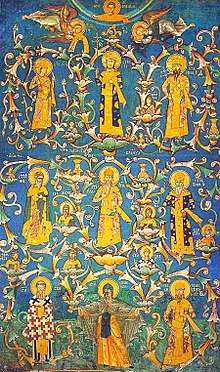
The history of the early medieval Serbian Principality is recorded in the 10th-century work De Administrando Imperio, which describes the Serbs as a people living in Roman Dalmatia, subordinate to the Byzantine Empire.[52] Numerous small Serbian states were created, chiefly under Vlastimorović and Vojislavjević dynasties, located in modern Bosnia and Herzegovina, Croatia, Montenegro, and Serbia, but the population's Serbian ethnic identity remains unclear and a matter of dispute.[53][54] With the decline of the Serbian state of Duklja in the late 11th century, "Raška" separated from it and replaced it as the most powerful Serbian state.[55] Prince Stefan Nemanja (r. 1169–96) conquered the neighbouring territories of Kosovo, Duklja and Zachlumia. The Nemanjić dynasty ruled over Serbia until the 14th century. Nemanja's older son, Stefan Nemanjić, became Serbia's first recognized king, while his younger son, Rastko, founded the Serbian Orthodox Church in the year 1219, and became known as Saint Sava after his death.[56]
Over the next 140 years, Serbia expanded its borders, from numerous smaller principalities, reaching to a unified Serbian Empire. Its cultural model remained Byzantine, despite political ambitions directed against the empire. The medieval power and influence of Serbia culminated in the reign of Stefan Dušan, who ruled the state from 1331 until his death in 1355. Ruling as Emperor from 1346, his territory included Macedonia, northern Greece, Montenegro, and almost all of modern Albania.[57] When Dušan died, his son Stephen Uroš V became Emperor.[58]
With Turkish invaders beginning their conquest of the Balkans in the 1350s, a major conflict ensued between them and the Serbs, the first major battle was the Battle of Maritsa (1371),[58] in which the Serbs were defeated.[59] With the death of two important Serb leaders in the battle, and with the death of Stephen Uroš that same year, the Serbian Empire broke up into several small Serbian domains.[58] These states were ruled by feudal lords, with Zeta controlled by the Balšić family, Raška, Kosovo and northern Macedonia held by the Branković family and Lazar Hrebeljanović holding today's Central Serbia and a portion of Kosovo.[59] Hrebeljanović was subsequently accepted as the titular leader of the Serbs because he was married to a member of the Nemanjić dynasty.[58] In 1389, the Serbs faced the Ottomans at the Battle of Kosovo on the plain of Kosovo Polje, near the town of Priština.[59] Both Lazar and Sultan Murad I were killed in the fighting.[59] The battle most likely ended in a stalemate, and afterwards Serbia enjoyed a short period of prosperity under despot Stefan Lazarević and resisted falling to the Turks until 1459.[59]
Early modern period
The Serbs had taken an active part in the wars fought in the Balkans against the Ottoman Empire, and also organized uprisings;[60][61] because of this, they suffered persecution and their territories were devastated – major migrations from Serbia into Habsburg territory ensued.[62] After allied Christian forces had captured Buda from the Ottoman Empire in 1686 during the Great Turkish War, Serbs from Pannonian Plain (present-day Hungary, Slavonia region in present-day Croatia, Bačka and Banat regions in present-day Serbia) joined the troops of the Habsburg Monarchy as separate units known as Serbian Militia.[63] Serbs, as volunteers, massively joined the Austrian side.[64]
Many Serbs were recruited during the devshirme system, a form of slavery in the Ottoman Empire, in which boys from Balkan Christian families were forcibly converted to Islam and trained for infantry units of the Ottoman army known as the Janissaries.[65][66][67][68] A number of Serbs who converted to Islam occupied high-ranking positions within the Ottoman Empire, such as Grand Vizier Sokollu Mehmed Pasha and Minister of War field marshal Omar Pasha Latas.
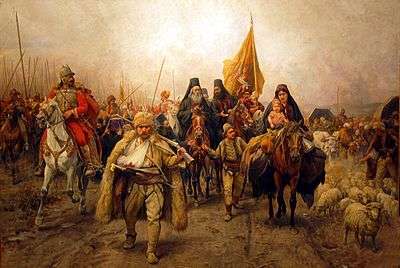
In 1688, the Habsburg army took Belgrade and entered the territory of present-day Central Serbia. Louis William, Margrave of Baden-Baden called Serbian Patriarch Arsenije III Čarnojević to raise arms against the Turks; the Patriarch accepted and returned to the liberated Peć. As Serbia fell under Habsburg control, Leopold I granted Arsenije nobility and the title of duke. In early November, Arsenije III met with Habsburg commander-in-chief, General Enea Silvio Piccolomini in Prizren; after this talk he sent a note to all Serb bishops to come to him and collaborate only with Habsburg forces.
A Great Migration of the Serbs (1690) to Habsburg lands was undertaken by Patriarch Arsenije III.[69] The large community of Serbs concentrated in Banat, southern Hungary and the Military Frontier included merchants and craftsmen in the cities, but mainly refugees that were peasants.[69]
The Serbian Revolution for independence from the Ottoman Empire lasted eleven years, from 1804 until 1815.[70] The revolution comprised two separate uprisings which gained autonomy from the Ottoman Empire that eventually evolved towards full independence (1835–1867).[71][72] During the First Serbian Uprising, led by Duke Karađorđe Petrović, Serbia was independent for almost a decade before the Ottoman army was able to reoccupy the country. Shortly after this, the Second Serbian Uprising began. Led by Miloš Obrenović, it ended in 1815 with a compromise between Serbian revolutionaries and Ottoman authorities.[73] Likewise, Serbia was one of the first nations in the Balkans to abolish feudalism.[74]
Modern period
In the early 1830s Serbia gained autonomy and its borders were recognized, with Miloš Obrenović being recognized as its ruler. Serbia is the fourth modern-day European country, after France, Austria and the Netherlands, to have a codified legal system, as of 1844.[75] The last Ottoman troops withdrew from Serbia in 1867, although Serbia's and Montenegro's independence was not recognized internationally until the Congress of Berlin in 1878.[62]
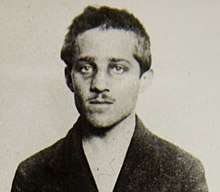
Serbia fought in the Balkan Wars of 1912–13, which forced the Ottomans out of the Balkans and doubled the territory and population of the Kingdom of Serbia. In 1914, a young Bosnian Serb student named Gavrilo Princip assassinated Archduke Franz Ferdinand of Austria, which directly contributed to the outbreak of World War I.[76] In the fighting that ensued, Serbia was invaded by Austria-Hungary. Despite being outnumbered, the Serbs defeated the Austro-Hungarians at the Battle of Cer, which marked the first Allied victory over the Central Powers in the war.[77] Further victories at the battles of Kolubara and the Drina meant that Serbia remained unconquered as the war entered its second year. However, an invasion by the forces of Germany, Austria-Hungary and Bulgaria overwhelmed the Serbs in the winter of 1915, and a subsequent withdrawal by the Serbian Army through Albania took the lives of more than 240,000 Serbs. Serb forces spent the remaining years of the war fighting on the Salonika Front in Greece, before liberating Serbia from Austro-Hungarian occupation in November 1918.[78] Serbia suffered the biggest casualty rate in World War I.[79]
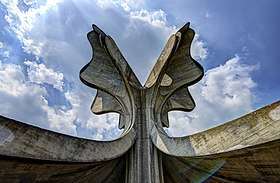
Following the victory in WWI Serbs subsequently formed the Kingdom of Serbs, Croats and Slovenes with other South Slavic peoples. The country was later renamed the Kingdom of Yugoslavia, and was led from 1921 to 1934 by King Alexander I of the Serbian Karađorđević dynasty.[80] During World War II, Yugoslavia was invaded by the Axis powers in April 1941. The country was subsequently divided into many pieces, with Serbia being directly occupied by the Germans.[81] Serbs in the Independent State of Croatia (NDH) were targeted for extermination as part of genocide by the Croatian ultra-nationalist, fascist Ustaše.[82][83][84][85] The Ustaše view of national and racial identity, as well as the theory of Serbs as an inferior race, was under the influence of Croatian nationalists and intellectuals from the end of the 19th and the beginning of the 20th century.[86][87][88] Jasenovac camp was notorious for the barbaric practices which occurred in it.[83] Sisak and Jastrebarsko concentration camp were specially formed for children.[89][90][91] Serbs in the NDH suffered among the highest casualty rates in Europe during the World War II, while the NDH was one of the most lethal regimes in the 20th century.[92][93][94] Diana Budisavljević, a humanitarian of Austrian descent, carried out rescue operations from Ustaše camps and saved more than 15,000 children, mostly Serbs.[95][96]
More than half a million Serbs were killed in the territory of Yugoslavia during World War II. Serbs in occupied Yugoslavia subsequently formed a resistance movement known as the Yugoslav Army in the Homeland, or the Chetniks. The Chetniks had the official support of the Allies until 1943, when Allied support shifted to the Communist Yugoslav Partisans, a multi-ethnic force, formed in 1941, which also had a large majority of Serbs in its ranks in the first two years of war. Over the entirety of the war, the ethnic composition of the Partisans was 53 percent Serb.[97][98] Later, after the fall of Italy in September 1943, other ethnic groups joined Partisans in larger numbers.[81]
At the end of the war, the Partisans, led by Josip Broz Tito, emerged victorious. Yugoslavia subsequently became a Communist state. Tito died in 1980, and his death saw Yugoslavia plunge into economic turmoil.[99] Yugoslavia disintegrated in the early 1990s, and a series of wars resulted in the creation of five new states. The heaviest fighting occurred in Croatia, Bosnia and Herzegovina, whose Serb populations rebelled and declared independence. The war in Croatia ended in August 1995, with a Croatian military offensive known as Operation Storm crushing the Croatian Serb rebellion and causing as many as 200,000 Serbs to flee the country. The Bosnian War ended that same year, with the Dayton Agreement dividing the country along ethnic lines. In 1998–99, a conflict in Kosovo between the Yugoslav Army and Albanians seeking independence erupted into full-out war, resulting in a 78-day-long NATO bombing campaign which effectively drove Yugoslav security forces from Kosovo.[100] Subsequently, more than 200,000 Serbs and other non-Albanians fled the province.[101] On 5 October 2000, Yugoslav President Slobodan Milosević was overthrown in a bloodless revolt after he refused to admit defeat in the 2000 Yugoslav general election.[102]
Demographics
There are nearly 8 million Serbs living in the Western Balkans. In Serbia (the nation state), around 6 million people identify themselves as Serbs, and constitute about 83% of the population. More than a million live in Bosnia and Herzegovina (predominantly in Republika Srpska), where they are one of the three constituent ethnic groups. The ethnic communities in Croatia and Montenegro number some 186,000 and 178,000 people, respectively, while another estimated 146,000 still inhabit the disputed area of Kosovo.[4] Smaller minorities exist in Slovenia and North Macedonia, some 36,000 and 39,000 people, respectively.
Outside of the Western Balkans, Serbs are an officially recognized minority in Romania (18,000), Hungary (7,000), Albania, the Czech Republic and Slovakia. There is a large diaspora in Western Europe, particularly in Germany, Austria, Switzerland, France, and Sweden. Outside Europe, there are significant Serb communities in the United States, Canada, Australia, South America and Southern Africa.
Diaspora

There are over 2 million Serbs in diaspora throughout the world, although some sources put that figure as high as 4 million.[103] The existence of a large diaspora is mainly a consequence of either economic or political (coercion or expulsions) reasons. There were several waves of Serb emigration:
- The first wave took place since the end of the 19th century and lasted until World War II and was caused by economic reasons; particularly large numbers of Serbs (mainly from peripheral ethnic areas such as Herzegovina, Montenegro, Dalmatia, and Lika) emigrated to the United States.
- The second wave took place after the end of World War II. At this time, members of royalist Chetniks and other political opponents of communist regime fled the country mainly going overseas (United States and Australia) and, to a lesser degree, United Kingdom.
- The third wave, and by far the largest wave, was economic emigration started in the 1960s when several Western European countries signed bilateral agreements with Yugoslavia allowing the recruitment of industrial workers to those countries, and lasted until the end of the 1980s. Main destinations were West Germany, Austria, and Switzerland, and to a lesser extent France and Sweden. That generation of diaspora is collectively known as gastarbajteri, after German gastarbeiter ("guest-worker"), since most of the emigrants headed for German-speaking countries.
- Recent emigration took place during the 1990s, and was caused by both political and economic reasons. The Yugoslav wars caused many Serbs from Croatia and Bosnia and Herzegovina to leave their countries in the first half of the 1990s. The economic sanctions imposed on Serbia caused an economic collapse with an estimated 300,000 people leaving Serbia during that period, 20% of which had a higher education.[104][105]
Language

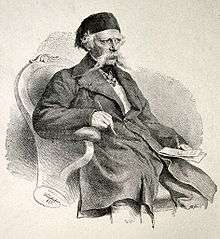
Serbs speak Serbian, a member of the South Slavic group of languages, specifically the Southwestern group. Standard Serbian is a standardized variety of Serbo-Croatian, and therefore mutually intelligible with Standard Croatian and Standard Bosnian (see Differences in standard Serbian, Croatian and Bosnian), which are all based on the Shtokavian dialect.[106]
Serbian is an official language in Serbia and Bosnia-Herzegovina and is a recognized minority language in Montenegro (although spoken by a plurality of population), Croatia, North Macedonia, Romania, Hungary, Czech Republic and Slovakia. Older forms of literary Serbian are Church Slavonic of the Serbian recension, which is still used for ecclesiastical purposes, and Slavonic-Serbian—a mixture of Serbian, Church Slavonic and Russian used from the mid-18th century to the first decades of the 19th century.
Serbian has active digraphia, using both Cyrillic and Latin alphabets.[107] Serbian Cyrillic was devised in 1814 by Serbian linguist Vuk Karadžić, who created the alphabet on phonemic principles.[108] Serbian Latin was created by Ljudevit Gaj and published in 1830. His alphabet mapped completely on Serbian Cyrillic which had been standardized by Vuk Karadžić a few years before.[109]
Loanwords in the Serbian language besides common internationalisms are mostly from Greek,[110] German[111] and Italian[112], while words of Hungarian origin are present mostly in the north. There are some Turkish loanwords used (but mostly in rural areas) and they are mostly related to food. A considerable number of those words are actually Persian in origin but entered Serbian through Ottomans and are therefore considered Turkisms.[113] There is considerable usage of French words as well, especially in military related terms.[111] One Serbian word that is used in many of the world's languages is "vampire" (vampir).[114][115][116][117]
Culture
Literature, icon painting, music, dance and medieval architecture are the artistic forms for which Serbia is best known. Traditional Serbian visual art (specifically frescoes, and to some extent icons), as well as ecclesiastical architecture, are highly reflective of Byzantine traditions, with some Mediterranean and Western influence.[118]
Many Serbian monuments and works of art have been lost forever due to various wars and peacetime marginalizations.[119]
In modern times (since the 19th century) Serbs also have a noteworthy classical music and works of philosophy.[120] Notable philosophers include Branislav Petronijević, Radomir Konstantinović, Ksenija Atanasijević, Nikola Milošević, Mihailo Marković, Svetozar Marković, Mihailo Đurić.
Art, music, theatre and cinema
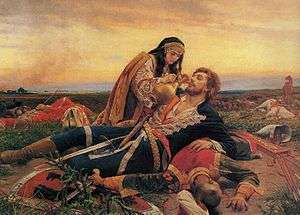
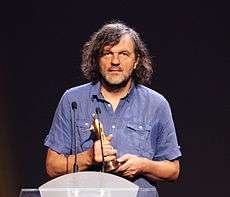
During the 12th and 13th centuries, many icons, wall paintings and manuscript miniatures came into existence, as many Serbian Orthodox monasteries and churches such as Hilandar, Žiča, Studenica, Sopoćani, Mileševa, Gračanica and Visoki Dečani were built.[121] The architecture of some of these monasteries is world-famous.[56] Prominent architectural styles in the Middle Ages were Raška architectural school, Morava architectural school and Serbo-Byzantin architectural style. During the same period UNESCO protected Stećak monumental medieval tombstones were built. The Independence of Serbia in the 19th century was soon followed with Serbo-Byzantine Revival in architecture.
Baroque and rococo trends in Serbian art emerged in the 18th century and are mostly represented in icon painting and portraits.[122] Most of the Baroque authors were from the territory of Austrian Empire, such as Nikola Nešković, Teodor Kračun, Teodor Ilić Češljar, Zaharije Orfelin and Jakov Orfelin.[123][124] Serbian painting showed the influence of Biedermeier and Neoclassicism as seen in works by Konstantin Danil[125] and Pavel Đurković.[126] Many painters followed the artistic trends set in the 19th century Romanticism, notably Đura Jakšić, Stevan Todorović, Katarina Ivanović and Novak Radonić.[127][128] Since the mid-1800s, Serbia has produced a number of famous painters who are representative of general European artistic trends.[121] One of the most prominent of these was Paja Jovanović, who painted massive canvases on historical themes such as the Migration of the Serbs (1896). Painter Uroš Predić was also prominent in the field of Serbian art, painting the Kosovo Maiden and Happy Brothers. While Jovanović and Predić were both realist painters, artist Nadežda Petrović was an impressionist and fauvist and Sava Šumanović was an accomplished Cubist. Painters Petar Lubarda, Vladimir Veličković and Ljubomir Popović were famous for their surrealism.[129] Marina Abramović is a world-renowned performance artist, writer, and art filmmaker.
Traditional Serbian music includes various kinds of bagpipes, flutes, horns, trumpets, lutes, psalteries, drums and cymbals. The kolo is the traditional collective folk dance, which has a number of varieties throughout the regions. Composer and musicologist Stevan Stojanović Mokranjac is considered one of the most important founders of modern Serbian music.[130][131] Other noted classical composers include Kornelije Stanković, Stanislav Binički, Petar Konjović, Miloje Milojević, Stevan Hristić, Josif Marinković, Luigi von Kunits and Vasilije Mokranjac.[132] Well-known musicians include Zdravko Čolić, Arsen Dedić, Predrag Gojković-Cune, Toma Zdravković, Milan Mladenović, Bora Đorđević, Momčilo Bajagić Bajaga, Đorđe Balašević, Ceca and others.
Serbia has produced many talented filmmakers, the most famous of whom are Slavko Vorkapić, Dušan Makavejev,[133] Živojin Pavlović, Goran Paskaljević, Emir Kusturica, Želimir Žilnik, Srdan Golubović and Mila Turajlić. Žilnik and Stefan Arsenijević won the Golden Bear award at Berlinale, while Mila Turajlić won the main award at IDFA. Kusturica became world-renowned after winning the Palme d'Or twice at the Cannes Film Festival, numerous other prizes, and is a UNICEF National Ambassador for Serbia.[134] Several Americans of Serb origin have been featured prominently in Hollywood. The most notable of these are Academy-award winners Karl Malden,[135] Steve Tesich, Peter Bogdanovich, Tony-winning theatre director Darko Tresnjak, Emmy-winning director Marina Zenovich and actors Iván Petrovich, Brad Dexter, Lolita Davidovich, Milla Jovovich and Stana Katic.
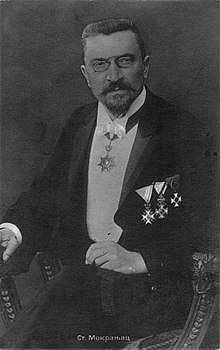 Stevan Mokranjac, composer and musical educator considered the "father of Serbian music."
Stevan Mokranjac, composer and musical educator considered the "father of Serbian music." Paja Jovanović, Serbia's most acclaimed realist painter.
Paja Jovanović, Serbia's most acclaimed realist painter.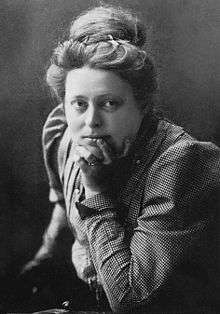
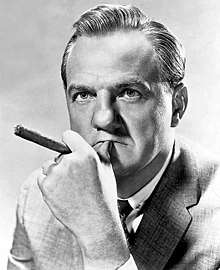 Karl Malden, Academy Award-winning Hollywood actor.
Karl Malden, Academy Award-winning Hollywood actor.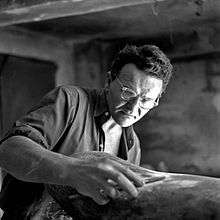 Vojin Bakić, a prominent sculptor
Vojin Bakić, a prominent sculptor
Literature
Most literature written by early Serbs was about religious themes. Various gospels, psalters, menologies, hagiographies, and essays and sermons of the founders of the Serbian Orthodox Church were written. At the end of the 12th century, two of the most important pieces of Serbian medieval literature were created– the Miroslav Gospels and the Vukan Gospels, which combined handwritten Biblical texts with painted initials and small pictures.[56] Notable Baroque-influenced authors were Andrija Zmajević, Gavril Stefanović Venclović, Jovan Rajić, Zaharije Orfelin and others. Dositej Obradović was the most prominent figure of the Age of Enlightenment, while the most notable Classicist writer was Jovan Sterija Popović, although his works also contained elements of Romanticism. Modern Serbian literature began with Vuk Karadžić's collections of folk songs in the 19th century, and the writings of Njegoš and Branko Radičević. The first prominent representative of Serbian literature in the 20th century was Jovan Skerlić, who wrote in pre–World War I Belgrade and helped introduce Serbian writers to literary modernism. The most important Serbian writer in the inter-war period was Miloš Crnjanski.[136]
The first Serb authors who appeared after World War II were Mihailo Lalić and Dobrica Ćosić.[137] Other notable post-war Yugoslav authors such as Ivo Andrić and Meša Selimović were assimilated to Serbian culture, and both identified as Serbs.[136] Andrić went on to win the Nobel Prize in Literature in 1961.[137] Danilo Kiš, another popular Serbian writer, was known for writing A Tomb for Boris Davidovich, as well as several acclaimed novels.[138] Amongst contemporary Serbian writers, Milorad Pavić stands out as being the most critically acclaimed, with his novels Dictionary of the Khazars, Landscape Painted with Tea and The Inner Side of the Wind bringing him international recognition. Highly revered in Europe and in South America, Pavić is considered one of the most intriguing writers from the beginning of the 21st century.[139] Charles Simic is a notable contemporary Serbian-American poet, former United States Poet Laureate and a Pulitzer Prize winner.[140]
 Petar II Petrović-Njegoš is considered one of the best poets of Serbian literature.
Petar II Petrović-Njegoš is considered one of the best poets of Serbian literature. Ivo Andrić, a novelist, poet and short story writer who won the Nobel Prize in 1961.
Ivo Andrić, a novelist, poet and short story writer who won the Nobel Prize in 1961. Desanka Maksimović, the most notable Serbian and Yugoslav female poet of the 20th century
Desanka Maksimović, the most notable Serbian and Yugoslav female poet of the 20th century Miloš Crnjanski, a poet of the expressionist wing of Serbian modernism and writer.
Miloš Crnjanski, a poet of the expressionist wing of Serbian modernism and writer. Borislav Pekić was a major writer and dramatist of the second half of the 20th century.
Borislav Pekić was a major writer and dramatist of the second half of the 20th century.
Education and science
Many Serbs have contributed to the field of science and technology. Serbian American scientist, inventor, physicist, mechanical engineer and electrical engineer Nikola Tesla is regarded as one of the most important inventors in history. He is renowned for his contributions to the discipline of electricity and magnetism in the late 19th and early 20th century.
Seven Serbian American engineers and scientists known as Serbo 7[141] took part in construction of the Apollo spaceship.[142] Physicist and physical chemist Mihajlo Pupin is best known for his landmark theory of modern electrical filters as well as for his numerous patents, while Milutin Milanković is best known for his theory of long-term climate change caused by changes in the position of the Earth in comparison to the Sun, now known as Milankovitch cycles.[143] Mihailo Petrović is known for having contributed significantly to differential equations and phenomenology, as well as inventing one of the first prototypes of an analog computer. Roger Joseph Boscovich was a Ragusan physicist, astronomer, mathematician and polymath of paternal Serbian origin[144][145][146][147] (although there are competing claims for Bošković's nationality) who produced a precursor of atomic theory and made many contributions to astronomy and also discovered the absence of atmosphere on the Moon. Jovan Cvijić founded modern geography in Serbia and made pioneering research on the geography of the Balkan Peninsula, Dinaric race and karst. Josif Pančić made contributions to botany and discovered a number of new floral species including the Serbian spruce.[148] Biologist and physiologist Ivan Đaja performed research in the role of the adrenal glands in thermoregulation, as well as pioneering work in hypothermia.[149][150] Valtazar Bogišić is considered to be a pioneer in the sociology of law and sociological jurisprudence. Gordana Vunjak-Novakovic is a Serbian American biomedical engineer focusing on engineering human tissues for regenerative medicine, stem cell research and modeling of disease. She is one of the most highly cited scientists of all times.[151]

 Mihajlo Pupin, physicist and physical chemist and a founding member of NACA which later became NASA.[152]
Mihajlo Pupin, physicist and physical chemist and a founding member of NACA which later became NASA.[152].jpg)
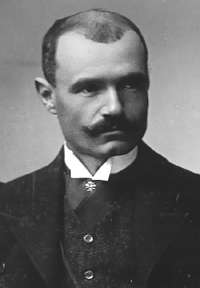 Mihailo Petrović, mathematician, contributor to the study of differential equations and inventor of early version of analog computer.
Mihailo Petrović, mathematician, contributor to the study of differential equations and inventor of early version of analog computer.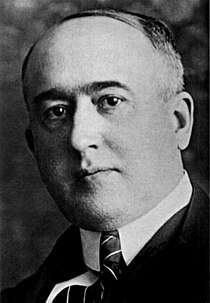
Names
There are several different layers of Serbian names. Serbian given names largely originate from Slavic roots: e.g., Vuk, Bojan, Goran, Zoran, Dragan, Milan, Miroslav, Vladimir, Slobodan, Dušan, Milica, Nevena, Vesna, Radmila. Other names are of Christian origin, originating from the bible (Hebrew, through Greek), such as Lazar, Mihailo, Ivan, Jovan, Ilija, Marija, Ana, Ivana. Along similar lines of non-Slavic Christian names are Greek ones such as: Stefan, Nikola, Aleksandar, Filip, Đorđe, Andrej, Jelena, Katarina, Vasilije, Todor, while those of Latin origin include: Marko, Antonije, Srđan, Marina, Petar, Pavle, Natalija, Igor (through Russian).
Most Serbian surnames are paternal, maternal, occupational or derived from personal traits. It is estimated that over two thirds of all Serbian surnames have the suffix -ić (-ић) ([itɕ]), a Slavic diminutive, originally functioning to create patronymics. Thus the surname Petrović means the "son of Petar" (from a male progenitor, the root is extended with possessive -ov or -ev). Due to limited use of international typewriters and unicode computer encoding, the suffix may be simplified to -ic, historically transcribed with a phonetic ending, -ich or -itch in foreign languages. Other common surname suffixes found among Serbian surnames are -ov, -ev, -in and -ski (without -ić) which is the Slavic possessive case suffix, thus Nikola's son becomes Nikolin, Petar's son Petrov, and Jovan's son Jovanov. Other, less common suffices are -alj/olj/elj, -ija, -ica, -ar/ac/an. The ten most common surnames in Serbia, in order, are Jovanović, Petrović, Nikolić, Marković, Đorđević, Stojanović, Ilić, Stanković, Pavlović and Milošević.[153]
Religion

Right: Church of Saint Sava, one of the largest Orthodox churches in the world
Serbs are predominantly Orthodox Christians. The autocephaly of the Serbian Orthodox Church, was established in 1219, as an Archbishopric, and raised to the Patriarchate in 1346.[154] It is led by the Serbian Patriarch, and consists of three archbishoprics, six metropolitanates and thirty-one eparchies, having around 10 million adherents. Followers of the church form the largest religious group in Serbia and Montenegro, and the second-largest in Bosnia and Herzegovina and Croatia. The church has an archbishopric in North Macedonia and dioceses in Western Europe, North America, South America[155] and Australia.[156]
The identity of ethnic Serbs was historically largely based on Orthodox Christianity and on the Serbian Church in particular. The conversion of the South Slavs from paganism to Christianity took place before the Great Schism. After the Schism, those who lived under the Orthodox sphere of influence became Orthodox and those who lived under the Catholic sphere of influence became Catholic.
With the arrival of the Ottoman Empire, some Serbs converted to Islam. This was particularly, but not wholly, the case in Bosnia.[157] Since the second half of the 19th century, a small number of Serbs converted to Protestantism,[158] while historically some Serbs were Catholics (especially in Bay of Kotor[159] and Dalmatia; e.g. Serb-Catholic movement in Dubrovnik).[160] In a personal correspondence with author and critic dr. Milan Šević in 1932, Marko Murat complained that Orthodox Serbs are not acknowledging the Catholic Serb community on the basis of their faith.[161] The remainder of Serbs remain predominantly Serbian Orthodox Christians.
Symbols
Among the most notable national and ethnic symbols are the flag of Serbia and the coat of arms of Serbia. The flag consists of a red-blue-white tricolour, rooted in Pan-Slavism, and has been used since the 19th century. Apart from being the national flag, it is also used officially in Republika Srpska (by Bosnian Serbs) and as the official ethnic Flag of Serbs of Croatia. The coat of arms, which includes both the Serbian eagle and Serbian cross, has also been officially used since the 19th century, its elements dating back to the Middle Ages, showing Byzantine and Christian heritage. These symbols are used by various Serb organisations, political parties and institutions. The Three-finger salute, also called the "Serb salute", is a popular expression for ethnic Serbs and Serbia, originally expressing Serbian Orthodoxy and today simply being a symbol for ethnic Serbs and the Serbian nation, made by extending the thumb, index, and middle fingers of one or both hands.
 Serbian national colours, in use since 1835
Serbian national colours, in use since 1835 Serbian cross
Serbian cross
Traditions and customs
- Folklore
Traditional clothing varies due to diverse geography and climate of the territory inhabited by the Serbs. The traditional footwear, opanci, is worn throughout the Balkans.[162] The most common folk costume of Serbia is that of Šumadija, a region in central Serbia,[163] which includes the national hat, the Šajkača.[164][165] Older villagers still wear their traditional costumes.[163] The traditional dance is the circle dance, called kolo. Zmijanje embroidery is a specific technique of embroidery practised by the women of villages in area Zmijanje on mountain Manjača and as such is a part of the UNESCO Representative List of the Intangible Cultural Heritage of Humanity. Pirot carpet is a variety of flat tapestry woven rug traditionally produced in Pirot, a town in southeastern Serbia.
- Traditions
Slava is the family's annual ceremony and veneration of their patron saint, a social event in which the family is together at the house of the patriarch. The tradition is an important ethnic marker of Serb identity.[34] Serbs usually regard the Slava as their most significant and most solemn feast day.[35] Serbs have their own customs regarding Christmas, which includes the sacral tree, the badnjak, a young oak. On Orthodox Easter, Serbs have the tradition of Slavic Egg decorating. Čuvari Hristovog groba is a religious/cultural practice of guarding a representation of Christ's grave on Good Friday in the Church of St. Nicholas by the Serbian Orthodox inhabitants in the town of Vrlika.
 Traditional Serbian costumes from Šumadija
Traditional Serbian costumes from Šumadija Old Silent dance from Glamoč.
Old Silent dance from Glamoč.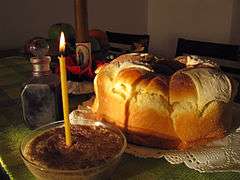 Slava, a family feast in honour of its patron saint.
Slava, a family feast in honour of its patron saint.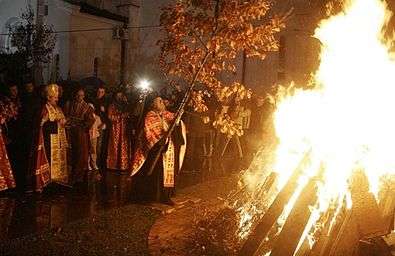
- The national instrument Gusle placed on Pirot carpet
Cuisine
.jpg)
Serbian cuisine is largely heterogeneous, with heavy Oriental, Central European and Mediterranean influences.[166] Despite this, it has evolved and achieved its own culinary identity. Food is very important in Serbian social life, particularly during religious holidays such as Christmas, Easter and feast days, i.e., slava.[166] Staples of the Serbian diet include bread, meat, fruits, vegetables, and dairy products. Traditionally, three meals are consumed per day. Breakfast generally consists of eggs, meat and bread. Lunch is considered the main meal, and is normally eaten in the afternoon. Traditionally, Turkish coffee is prepared after a meal, and is served in small cups.[166] Bread is the basis of all Serbian meals, and it plays an important role in Serbian cuisine and can be found in religious rituals. A traditional Serbian welcome is to offer bread and salt to guests, and also slatko (fruit preserve). Meat is widely consumed, as is fish. Serbian specialties include kajmak (a dairy product similar to clotted cream), proja (cornbread), kačamak (corn-flour porridge), and gibanica (cheese and kajmak pie). Ćevapčići, caseless grilled and seasoned sausages made of minced meat, is the national dish of Serbia.[166]
Šljivovica (Slivovitz) is the national drink of Serbia in domestic production for centuries, and plum is the national fruit. The international name Slivovitz is derived from Serbian.[167] Plum and its products are of great importance to Serbs and part of numerous customs.[168] A Serbian meal usually starts or ends with plum products and Šljivovica is served as an aperitif.[168] A saying goes that the best place to build a house is where a plum tree grows best.[168] Traditionally, Šljivovica (commonly referred to as "rakija") is connected to Serbian culture as a drink used at all important rites of passage (birth, baptism, military service, marriage, death, etc.), and in the Serbian Orthodox patron saint celebration (slava).[168] It is used in numerous folk remedies, and is given certain degree of respect above all other alcoholic drinks. The fertile region of Šumadija in central Serbia is particularly known for its plums and Šljivovica.[169] Serbia is the largest exporter of Slivovitz in the world, and second largest plum producer in the world.[170][171]
Sport
Serbs are known for their sporting achievements, and have produced a number of talented athletes.
The Hungarian citizen Momčilo Tapavica was the first Slav and Serb to win an Olympic medal, in the 1896 Summer Olympics.[172][173]
Over the years Serbia has been home to many internationally successful football players such as Dragan Džajić (officially recognized as "the best Serbian footballer of all times" by Football Association of Serbia; 1968 Ballon d'Or third place) and more recent likes of Dejan Stanković (Serbia's most capped player), Nemanja Vidić (Premier League Player of the Season and member of FIFPro World XI, Branislav Ivanović and Nemanja Matić. Radomir Antić is a notable football coach, best known for his work with the national team, Real Madrid C.F. and FC Barcelona. Serbia has developed a reputation as one of the world's biggest exporters of expat footballers.[174]

A total of 22 Serbian players have played in the NBA in the last two decades, including three-time NBA All-Star Predrag "Peja" Stojaković and NBA All-Star and FIBA Hall of Fame inductee Vlade Divac. Serbian players that made a great impact in Europe include four members of the FIBA Hall of Fame from the 1960s and 1970s – Dragan Kićanović, Dražen Dalipagić, Radivoj Korać, and Zoran Slavnić – as well as recent stars such as Dejan Bodiroga (2002 All-Europe Player of the Year), Aleksandar Đorđević (1994 and 1995 Mr. Europa) and currently active Miloš Teodosić (2009–2010 Euroleague MVP) and NBA All-Star Nikola Jokić. "Serbian coaching school" produced many of the most successful European coaches of all times, such as Željko Obradović (a record nine Euroleague titles), Božidar Maljković (four Euroleague titles), Aleksandar Nikolić (three Euroleague titles), Dušan Ivković (two Euroleague titles), and Svetislav Pešić (one Euroleague title).[176]
Novak Djokovic, seventeen-time Grand Slam champion and 2011, 2014 and 2015 Laureus Sportsman of the Year, finished 2011, 2012, 2014, and 2015 as the No. 1 ranked player in the world. Ana Ivanovic (champion of 2008 French Open) and Jelena Janković were both ranked No. 1 in the WTA Rankings, while Nenad Zimonjić and Slobodan Živojinović were ranked No. 1 in doubles.
Notable water polo players are Vladimir Vujasinović, Aleksandar Šapić, Vanja Udovičić, Andrija Prlainović and Filip Filipović.
Other noted Serbian athletes, including Olympic and world champions and medalists, are: swimmer Milorad Čavić, volleyball player Nikola Grbić, handball player Svetlana Kitić, long-jumper Ivana Španović, shooter Jasna Šekarić, sprint canoer Marko Tomićević, judoka Nemanja Majdov[177] and taekwondoist Milica Mandić.
A number of sportspeople of Serb origin represented other nations, such as tennis players Daniel Nestor, Jelena Dokic, Milos Raonic and Kristina Mladenovic, NHL player Milan Lucic, NBA All-star Pete Maravich, wrestler Jim Trifunov, racquetball player Rhonda Rajsich and racing driver Bill Vukovich.[178]
Notes
- Kosovo is the subject of a territorial dispute between the Republic of Kosovo and the Republic of Serbia. The Republic of Kosovo unilaterally declared independence on 17 February 2008, but Serbia continues to claim it as part of its own sovereign territory. The two governments began to normalise relations in 2013, as part of the 2013 Brussels Agreement. Kosovo is currently recognized as an independent state by 97 out of the 193 United Nations member states. In total, 112 UN member states recognized Kosovo at some point, of which 15 later withdrew their recognition.
Reference
- Popis 2013 (PDF). Sarajevo: BHAS. June 2016. Archived from the original (PDF) on 30 June 2016. Retrieved 30 June 2016.
- "Population by Ethnicity, censuses 1971–2011". Croatian Bureau of Statistics.
- "Census of Population, Households and Dwellings in Montenegro 2011" (PDF). 12 July 2011. Archived (PDF) from the original on 27 July 2011. Retrieved 13 July 2011.
- "Community Profile: Serb Community" (PDF). ECMI Kosovo. 2013. Archived (PDF) from the original on 16 January 2017. Cite journal requires
|journal=(help) - "Slovenian census". 2011. Archived from the original on 17 November 2014.
- Државен завод за статистика. "Попис на населението, домаќинствата и становите во Република Македонија, 2002: Дефинитивни податоци" (PDF). Archived (PDF) from the original on 22 September 2010.
- "Tab11. Populaţia stabilă după etnie şi limba maternă, pe categorii de localităţi". Rezultate Definitive_RPL_2011. Institutul Naţional de Statistică. 2011. Archived from the original on 9 November 2013. Retrieved 17 April 2014.
- "Srbi u Nemačkoj – Srbi u Njemačkoj – Zentralrat der Serben in Deutschland". zentralrat-der-serben.de. Archived from the original on 8 December 2015. Retrieved 26 August 2017.
- "Srbi u Austriji traže status nacionalne manjine". Blic. 2 October 2010. Archived from the original on 9 January 2015.
- "saez.ch" (PDF). Archived from the original (PDF) on 22 March 2012. Cite journal requires
|journal=(help) - Mediaspora (2002). "Rezultat istrazivanja o broju Srpskih novinara i medija u svetu". Srpska dijaspora. Archived from the original on 27 January 2016.
- "So, just how many Serbs live in Britain? Britić figures defy census figures of 2001". Ebritic.com. 3 June 2011. Archived from the original on 4 September 2015.
- "Statistiche demografiche ISTAT" (PDF). Demo.istat.it. Archived from the original (PDF) on 1 April 2014. Retrieved 3 October 2014.
- "Innvandring og innvandrere 2006" (PDF). Archived (PDF) from the original on 24 September 2015.
- Vukovich, Gabriella (2018). Mikrocenzus 2016 – 12. Nemzetiségi adatok [2016 microcensus – 12. Ethnic data] (PDF). Hungarian Central Statistical Office (in Hungarian). Budapest. ISBN 978-963-235-542-9. Retrieved 9 January 2019.
- Bureau, U.S. Census. "American FactFinder – Results". factfinder2.census.gov. Archived from the original on 28 January 2015.
- "2011 National Household Survey: Data tables". 2.statcan.gc.ca. Archived from the original on 24 September 2013. Retrieved 17 April 2014.
- The People of Australia – Statistics from the 2011 Census (PDF). Department of Immigration and Border Protection. 2014. p. 59. ISBN 978-1-920996-23-9. Archived from the original (PDF) on 14 July 2014. Retrieved 16 February 2015.
Ancestry
- Serbia, RTS, Radio televizija Srbije, Radio Television of. "Afrika i Srbija na vezi". Archived from the original on 2 April 2015.
- "Srbi u Dubaiju pokrenuli inicijativu za otvaranje konzulata". telegraf.rs. Archived from the original on 27 August 2017.
- Stefanovic-Banovic, Milesa; Pantovic, Branislav (2013). "'Our' diaspora in Argentina: Historical overview and preliminary research" (PDF). Glasnik Etnografskog Instituta. 61: 119–131. doi:10.2298/GEI1301119S.
На територији Републике Аргентине данас живи око 30 0002 људи српског и црногорског порекла, већим делом са простора данашње Црне Горе и Хрватске, а мањим делом из Србије и Босне и Херцеговине.
- "Serbs". www.joshuaproject.net. Retrieved 13 August 2020.
- Marty, Martin E. (1997). Religion, Ethnicity, and Self-Identity: Nations in Turmoil. University Press of New England. ISBN 0-87451-815-6.
[...] the three ethnoreligious groups that have played the roles of the protagonists in the bloody tragedy that has unfolded in the former Yugoslavia: the Christian Orthodox Serbs, the Roman Catholic Croats, and the Muslim Slavs of Bosnia.
- "Popis stanovništva, domaćinstava i stanova u Crnoj Gori 2011. godine" (PDF). Archived (PDF) from the original on 9 March 2014. Cite journal requires
|journal=(help) - Cirkovic, Sima M. (15 April 2008). The Serbs. John Wiley & Sons. ISBN 9781405142915.
- Djilas, Aleksa (1991). The Contested Country: Yugoslav Unity and Communist Revolution, 1919–1953. Harvard University Press. p. 181. ISBN 9780674166981.
- Byford, Jovan (1 January 2008). Denial and Repression of Antisemitism: Post-communist Remembrance of the Serbian Bishop Nikolaj Velimirovi?. Central European University Press. ISBN 9789639776159.
- Longinović, Toma (12 August 2011). Vampire Nation: Violence as Cultural Imaginary. Duke University Press. ISBN 9780822350392.
- "Serbia home to highest number of refugees and IDPs in Europe". B92. Retrieved 28 April 2020.
- "Serbia: Europe's largest proctracted refugee situation". OSCE. Retrieved 28 April 2020.
- S. Cross, S. Kentera, R. Vukadinovic, R. Nation (7 May 2013). Shaping South East Europe's Security Community for the Twenty-First Century: Trust, Partnership, Integration. Springer. p. 169. ISBN 9781137010209. Retrieved 28 April 2020.CS1 maint: multiple names: authors list (link)
- Ana S. Trbovich (2008). A Legal Geography of Yugoslavia's Disintegration. Oxford University Press, USA. pp. 69–. ISBN 978-0-19-533343-5. Archived from the original on 2 January 2016.
- Christopher Catherwood (1 January 2002). Why the Nations Rage: Killing in the Name of God. Rowman & Littlefield. pp. 135–. ISBN 978-0-7425-0090-7.
- Ethnologia Balkanica. LIT Verlag Münster. pp. 70–. GGKEY:ES2RY3RRUDS. Archived from the original on 2 January 2016.
- Celia Jaes Falicov (1991). Family Transitions: Continuity and Change Over the Life Cycle. New York City: Guilford Press. p. 219. ISBN 978-0-89862-484-7.
- Kushniarevich, Alena; et al. (2015). "Genetic Heritage of the Balto-Slavic Speaking Populations: A Synthesis of Autosomal, Mitochondrial and Y-Chromosomal Data". PLoS ONE. 10 (9): e0135820. Bibcode:2015PLoSO..1035820K. doi:10.1371/journal.pone.0135820. PMC 4558026. PMID 26332464.
- Todorović, I.; Vučetić-Dragović, A.; Marić, A. (2014). "Компаративни аналитички осврт на најновија генетска истраживања порекла Срба и становништва Србије – етнолошка перспектива" (PDF). Glasnik Etnografskog instituta SANU. 62 (2). doi:10.2298/GEI1402099T. Archived (PDF) from the original on 17 November 2015.
- "Y-DNA haplogroups of ethnic Serbs". Порекло (in Serbian). 12 June 2019. Retrieved 24 December 2019.
- "Body Height and Its Estimation Utilizing Arm Span Measurements in Serbian Adults" (PDF). Archived (PDF) from the original on 26 March 2017. Retrieved 20 March 2017. Cite journal requires
|journal=(help) - Grasgruber, Pavel; Popović, Stevo; Bokuvka, Dominik; Davidović, Ivan; Hřebíčková, Sylva; Ingrová, Pavlína; Potpara, Predrag; Prce, Stipan; Stračárová, Nikola (2017). "The mountains of giants: An anthropometric survey of male youths in Bosnia and Herzegovina". Royal Society Open Science. 4 (4): 161054. doi:10.1098/rsos.161054. PMC 5414258. PMID 28484621.
- Fine 1991, pp. 26–41.
- Fine 1991, p. 29.
- Fine 1991, p. 33.
- Živković 2002, p. 187.
- Fine 1991, pp. 38, 41; Ćorović 2001, "Балканска култура у доба сеобе Словена"
- Sima M. Ćirković, SRBI MEĐU EUROPSKIM NARODIMA,(Serbs) 2008. http://www.mo-vrebac-pavlovac.hr/attachments/article/451/Sima%20%C4%86irkovi%C4%87%20SRBI%20ME%C4%90U%20EVROPSKIM%20NARODIMA.pdf #page=26-27
- Pertz 1845, p. 83.
- Scholz 1970, p. 111.
- Ćirković 2004, p. 14.
- Fine 2005, p. 35.
- Curta 2006, p. 136.
- Moravcsik 1967, pp. 153–155.
- Živković, Tibor (2012). De conversione Croatorum et Serborum: A Lost Source. Belgrade: The Institute of History. pp. 161–162, 181–196.
- Budak, Neven (1994). Prva stoljeća Hrvatske (PDF). Zagreb: Hrvatska sveučilišna naklada. pp. 58–61. ISBN 953-169-032-4. Archived from the original (PDF) on 4 May 2019. Retrieved 4 May 2019.
Glavnu poteškoću uočavanju etničke raznolikosti Slavena duž jadranske obale činilo je tumačenje Konstantina Porfirogeneta, po kojemu su Neretvani (Pagani), Zahumljani, Travunjani i Konavljani porijeklom Srbi. Pri tome je car dosljedno izostavljao Dukljane iz ove srpske zajednice naroda. Čini se, međutim, očitim da car ne želi govoriti ο stvarnoj etničkoj povezanosti, već da su mu pred očima politički odnosi u trenutku kada je pisao djelo, odnosno iz vremena kada su za nj prikupljani podaci u Dalmaciji. Opis se svakako odnosi na vrijeme kada je srpski knez Časlav proširio svoju vlast i na susjedne sklavinije, pored navedenih još i na Bosnu. Zajedno sa širenjem političke prevlasti, širilo se i etničko ime, što u potpunosti odgovara našim predodžbama ο podudarnosti etničkog i političkog nazivlja. Upravo zbog toga car ne ubraja Dukljane u Srbe, niti se srpsko ime u Duklji/Zeti udomaćilo prije 12. stoljeća. Povjesničari koji su bez imalo zadrške Dukljane pripisivali Srbima, pozivali su se na Konstantina, mada im on nije za takve teze davao baš nikakve argumente, navodeći Dukljane isključivo pod njihovim vlastitim etnonimom.
- Miller 2005, p. 533.
- Cox 2002, p. 20.
- Cox 2002, p. 21.
- Cox 2002, pp. 23–24.
- Ćirković 2004.
- Rajko L. Veselinović (1966). (1219–1766). Udžbenik za IV razred srpskih pravoslavnih bogoslovija. (Yu 68-1914). Sv. Arh. Sinod Srpske pravoslavne crkve. pp. 70–71.
Устанак Срба у Банату и спалмваъье моштийу св. Саве 1594. — Почетком 1594. године Срби у Банату почели су нападати Турке. Устанак се -нарочито почео ширити после освадаъьа и спашьиваъьа Вршца од стране чете -Петра Маджадца. Устаници осводе неколико утврЬених градова (Охат [...]
- Editions speciales. Naučno delo. 1971.
Дошло ]е до похреаа Срба у Ба- нату, ко]и су помагали тадаппьи црногоски владика, Херувим и тре- бюьски, Висарион. До покрета и борбе против Ту рака дошло ]е 1596. године и у Цр- иэ] Гори и сус]едним племенима у Харцеговгаш, нарочито под утица- ]ем поменутог владике Висариона. Идупе, 1597. године, [...] Али, а\адика Висарион и во]вода Грдан радили су и дал>е на организован>у борбе, па су придобили и ...
- Fotić 2008a, p. 517–519.
- Gavrilović, Slavko (2006), "Isaija Đaković" (PDF), Zbornik Matice Srpske za Istoriju (in Serbian), 74, Novi Sad: Matica Srpska, Department of Social Sciences, Proceedings i History, p. 7, archived from the original (PDF) on 16 September 2011, retrieved 21 December 2011
- Janićijević, Jovan (1996), Kulturna riznica Srbije (in Serbian), IDEA, p. 70, archived from the original on 2 January 2016,
Велики или Бечки рат Аустрије против Турске, у којем су Срби, као добровољци, масовно учествовали на аустријској страни
- A ́goston & Masters 2010, p. 383.
- Riley-Smith 2001, p. 251.
- Rodriguez 1997, p. 6.
- Kia 2011, p. 62.
- Jelavich 1983, p. 145.
- Mitev, Plamen (2010). Empires and Peninsulas: Southeastern Europe Between Karlowitz and the Peace of Adrianople, 1699-1829. p. 144. ISBN 978-3643106117.
- MacKenzie, David (1988). "Reviewed work: Knezevina Srbija (1830–1839)., Rados Ljusic". Slavic Review. 47 (2): 362–363. doi:10.2307/2498513. JSTOR 2498513.
- Misha Glenny. "The Balkans Nationalism, War and the Great Powers, 1804–1999". The New York Times. Archived from the original on 15 April 2009. Retrieved 6 April 2010.
- Royal Family. "200 godina ustanka". Royalfamily.org. Archived from the original on 7 February 2010. Retrieved 28 April 2010.
- Gordana Stokić (January 2003). "Bibliotekarstvo i menadžment: Moguća paralela" (PDF) (in Serbian). Narodna biblioteka Srbije. Archived from the original on 7 March 2016.
- Avramović, Sima (2014). "Srpski građanski zakonik (1844) i pravni transplanti – kopija austrijskog uzora ili više od toga?" (PDF). Srpski Građanski Zakonik – 170 Godina.
- Miller 2005, p. 542.
- Pavlowitch 2002, p. 94.
- Miller 2005, pp. 542–543.
- Radivojević, Biljana; Penev, Goran (2014). "Demographic losses of Serbia in the first world war and their long-term consequences". Economic Annals. 59 (203): 29–54. doi:10.2298/EKA1403029R.
- Miller 2005, p. 544.
- Miller 2005, p. 545.
- Yeomans 2015, p. 18.
- Levy 2009.
- "Ustasa" (PDF). Yad Vashem. Retrieved 25 June 2018.
- "Croatia: Serbs". Minority Rights Group International.
- Yeomans 2013, p. 7.
- Kallis 2008, pp. 130–131.
- Bartulin 2013, p. 124.
- "SISAK CAMP". Jasenovac Memorial Cite. Retrieved 30 January 2018.
- Marija Vuselica: Regionen Kroatien in Der Ort des Terrors: Arbeitserziehungslager, Ghettos, Jugendschutzlager, Polizeihaftlager, Sonderlager, Zigeunerlager, Zwangsarbeiterlager, Volume 9 of Der Ort des Terrors, Publisher C.H.Beck, 2009, ISBN 9783406572388 pages 321–323
- Anna Maria Grünfelder: Arbeitseinsatz für die Neuordnung Europas: Zivil- und ZwangsarbeiterInnen aus Jugoslawien in der "Ostmark" 1938/41-1945, Publisher Böhlau Verlag Wien, 2010 ISBN 9783205784531 pages 101–106
- Charny 1999, pp. 18–23.
- Payne 2006, pp. 18–23.
- Dulić 2006.
- Kolanović, Josip, ed. (2003). Dnevnik Diane Budisavljević 1941–1945. Zagreb: Croatian State Archives and Public Institution Jasenovac Memorial Area. pp. 284–85. ISBN 978-9-536-00562-8.CS1 maint: ref=harv (link)
- Lomović, Boško (2014). Die Heldin aus Innsbruck – Diana Obexer Budisavljević. Belgrade: Svet knjige. p. 28. ISBN 978-86-7396-487-4.CS1 maint: ref=harv (link)
- Hoare 2011, p. 207.
- Calic 2019, p. 463.
- Miller 2005, pp. 546–553.
- Miller 2005, pp. 558–562.
- Gall, Carlotta (7 May 2000). "New Support to Help Serbs Return to Homes in Kosovo". The New York Times.
- Pavlowitch 2002, p. 225.
- "Biz – Vesti – Srbi za poslom idu i na kraj sveta". B92. Archived from the original on 13 December 2014. Retrieved 17 April 2014.
- "Serbia seeks to fill the '90s brain-drainage gap". EMG.rs. 5 September 2008. Archived from the original on 29 May 2012.
- "Survey S&M 1/2003". Yugoslav Survey.
- Benjamin W. Fortson, IV (7 September 2011). Indo-European Language and Culture: An Introduction. John Wiley & Sons. p. 431. ISBN 978-1-4443-5968-8. Archived from the original on 2 January 2016.
- Dejan Ivković (2013). "Pragmatics meets ideology: Digraphia and non-standard orthographic practices in Serbian online news forums". Journal of Language and Politics. John Benjamins Publishing Company. 12 (3). doi:10.1075/jlp.12.3.02ivk.
- Mojca Ramšak (2008). "Karadžić, Vuk Stefanović (1787–1864)". In Donald Haase (ed.). The Greenwood Encyclopedia of Folktales and Fairy Tales: G-P. Westport, Connecticut: Greenwood Publishing Group. p. 531. ISBN 978-0-313-33443-6. Archived from the original on 3 February 2017.
- Comrie, Bernard; Corbett, Greville G. (1 September 2003). The Slavonic Languages. Taylor & Francis. p. 45. ISBN 978-0-203-21320-9. Retrieved 23 December 2013.
... following Vuk's reform of Cyrillic (see above) in the early nineteenth century, Ljudevit Gaj in the 1830s performed the same operation on Latinica,...
- Јасна Влајић-Поповић, „Грецизми у српском језику: осврт на досадашња и поглед на будућа истраживања“, Јужнословенски филолог, књ. 65 (2009), Београд, стр. 375–403
- Лексикон страних речи и израза / Милан Вујаклија, Просвета, Београд (1954) (in Serbian)
- Dejan J. Ivović (2013). "ITALIJANIZMI U GOVORNOM JEZIKU" (PDF). Retrieved 23 July 2019.
- Абдулах Шкаљић – Турцизми у српскохрватском језику
- "Deutsches Wörterbuch von Jacob Grimm und Wilhelm Grimm. 16 Bde. (in 32 Teilbänden). Leipzig: S. Hirzel 1854–1960" (in German). Archived from the original on 26 September 2007. Retrieved 13 June 2006.
- "Vampire". Merriam-Webster Online Dictionary. Archived from the original on 14 June 2006. Retrieved 13 June 2006.
- "Trésor de la Langue Française informatisé" (in French). Archived from the original on 30 December 2017. Retrieved 13 June 2006.
- Dauzat, Albert (1938). Dictionnaire étymologique de la langue française (in French). Paris: Librairie Larousse. OCLC 904687.
- Димитрије Оболенски „Византијски комонвелт“, Београд. 1991
- Kadijević, Aleksandar Đ. (2017). "About typology and meaning of the Serbian public architectural monuments (19–20th centuries)". Matica srpska journal for fine arts. 45.
- Cox 2002, pp. 11–12.
- Cox 2002, p. 12.
- Milošević, Ana. "OLD ICON PAINTING AND THE RELIGIOUS REVIVAL IN THE 'KINGDOM OF SERBIA' DURING AUSTRIAN RULE 1718–1739". Byzantine Heritage and Serbian Art III Imagining the Past the Reception of the Middle Ages in Serbian Art from the 18 Th to the 21 St Century.
- "Projekat Rastko: Istorija srpske kulture". rastko.rs. Retrieved 26 July 2019.
- "18. vek". Nedeljnik Vreme. Retrieved 26 July 2019.
- "Biedermeier Of The 19th Century". galerijamaticesrpske.rs. Retrieved 28 April 2019.
- "19. vek". Nedeljnik Vreme. Retrieved 28 April 2019.
- Mitchell, Laurence (2010). Serbia. Bradt Travel Guides. p. 43. ISBN 978-1-84162-326-9.
- "Romanticism Of The 19th Century". galerijamaticesrpske.rs. Retrieved 10 June 2019.
- Cox 2002, p. 121.
- "Projekat Rastko: Istorija srpske kulture". Rastko.rs. Archived from the original on 3 June 2012. Retrieved 24 May 2012.
- "Stevan Stojanović Mokranjac (1856—1914)". Riznicasrpska.net. 28 September 1914. Archived from the original on 26 September 2013. Retrieved 24 May 2012.
- Bills, John William. "The 10 Best Classical Composers From Serbia". Culture Trip. Retrieved 10 July 2019.
- Cox 2002, p. 13.
- "Emir Kusturica". UNICEF Serbia. Archived from the original on 12 August 2014.
- "Inicijativa da Karl Malden u Beogradu dobije spomenik i ulicu". Blic. 30 May 2013. Archived from the original on 29 June 2015.
- Miller 2005, pp. 565–567.
- Bédé & Edgerton 1980, p. 734.
- Miller 2005, pp. –565–567.
- Sollars & Jennings 2008, p. 604.
- "Serbian roots, American spirit: An interview with Charles Simic". Balkan Insight. 25 May 2011. Retrieved 2 August 2019.
- "Serbs of the Apollo Space Program Honored | Serbian Orthodox Church [Official web site]". www.spc.rs. Retrieved 2 August 2019.
- Vladimir. "The Meaning of Reality". Serbica Americana. Retrieved 2 August 2019.
- "Great Serbian scientists". Consulate General of the Republic of Serbia. Archived from the original on 12 June 2008.
- "People « National Tourism Organisation of Serbia". serbia.travel. Archived from the original on 23 December 2014. Retrieved 12 January 2015.
- Jandric, Miroslav (2011). Three Centuries from the Birth of Rudjer Boskovic (1711– 1787) (PDF). pp. 449 (footnote).
- "Boris Tadić: Ruđer Bošković je bio Srbin katolik. Nadam se da me Hrvati neće krivo shvatiti – Jutarnji List". jutarnji.hr.
- Georgevich, Dragoslav (1977). Serbian Americans and their communities in Cleveland. p. 73.
- Lubarda, Biljana. "Plant species and subspecies discovered by Dr. Josif Pančić 1 – distribution and floristic importance". Cite journal requires
|journal=(help) - General Encyclopedia of the Yugoslav Lexicographical Institute, III edition, Vol 2 C-Fob. Jugoslavenski leksikografski zavod “Miroslav Krleža”. 1977.
- "Short biography".
- "Gordana Vunjak-Novakovic – Google Scholar Citations". Google Scholar.
- "NASA - First Meeting". Nasa.gov. Retrieved 27 December 2012.
- Tanjug. "Srbija, zemlja Milice i Dragana : Društvo : POLITIKA". Politika. Archived from the original on 16 June 2014. Retrieved 17 April 2014.
- Fotić 2008b, p. 519–520.
- "О НАМА | Православна Црква у Чилеу". www.pravoslavie.cl. Retrieved 8 February 2020.
- Cvetković 2012, p. 130.
- World and Its Peoples. Marshall Cavendish. 2010. ISBN 9780761479031.
- Bjelajac, Branko (2002). "Protestantism in Serbia". Religion, State and Society. 30 (3): 169–218. doi:10.1080/0963749022000009225. ISSN 0963-7494.
- "Nisu svi Srbi pravoslavne vere". Politika. Retrieved 26 September 2019.
- Christian Promitzer; Klaus-Jürgen Hermanik & Eduard Staudinger. (Hidden) Minorities: Language and Ethnic Identity Between Central Europe and the Balkans. The Lit Verlag in 2009. Archived from the original on 2 January 2016. Retrieved 5 February 2013.
- Bozic, Sofija (1 January 2014). "Umetnost, politika, svakodnevica – tematski okviri prijateljstva Marka Murata i Milana Sevica". Prilozi za knjizevnost i jezik, istoriju i folklor: 203–217. doi:10.2298/PKJIF1480203B.
...Ove tvoje poslednje reklo bi se da nisi primio moju gde sam Ti doneo jednu istinitu priču o Zmaju kad ono bijaše u Dubr. o otkrivanju spomenika Dživu Gunduliću. Pitao Zmaj jednog mladog dubrovačkog majstora da mu pokaže gde je srpska crkva. Mladić odgovori: "Koja?" Zmaj: "Srpska". Mladić: "Koja? Ovdi su u nas sve srpske. Koju mislite?" Zmaj: "Pravoslavnu". Mladić: "E! tako recite. Pravoslavna vam je она онамо". I Zmaj je pohvalio našega meštra koji mu je dao dobru lekciju. ― Ali sve zaludu, Milane moj! Ovi naši pravoslavci (koji ne vjeruju ništa, ateiste) zbog vere ne priznaju nas. Nismo im pravi. Ne veruju nikome. Ni vama šojkama. Valjda im niste dovoljno pravoslavni!! Jer su oni jako skrupolozni in re fidei et morum. Et morum, Milane moj! E se non ridi ― piange piuttosto. Zato nam ide sve ovako manjifiko. Hoćemo mi našu specijalnu kulturu! Sve su drugo švabe kelerabe etcetc!
- Mirjana Prošić-Dvornić (1989). Narodna nošnja Šumadije. Kulturno-Prosvjetni Sabor Hrvatske. p. 62. Archived from the original on 2 January 2016.
- Dragoljub Zamurović; Ilja Slani; Madge Phillips-Tomašević (2002). Serbia: life and customs. ULUPUDS. p. 194. Archived from the original on 2 January 2016.
- Deliso, Christopher (2009). Culture and Customs of Serbia and Montenegro. Westport, Connecticut: Greenwood Publishing Group. p. 97. ISBN 978-0-313-34436-7.
- Resić, Sanimir; Plewa, Barbara Törnquist (2002). The Balkans in Focus: Cultural Boundaries in Europe. Lund, Sweden: Nordic Academic Press. p. 48. ISBN 978-91-89116-38-2. Archived from the original on 2 January 2016.
- Albala 2011, pp. 328–330.
- Haraksimová, Erna; Rita Mokrá; Dagmar Smrčinová (2006). "slivovica". Anglicko-slovenský a slovensko-anglický slovník. Praha: Ottovo nakladatelství. p. 775. ISBN 80-7360-457-4.
- Stephen Mennell (2005). Culinary Cultures of Europe: Identity, Diversity and Dialogue. Council of Europe. p. 383. ISBN 978-92-871-5744-7. Archived from the original on 23 June 2013.
- Grolier Incorporated (2000). The encyclopedia Americana. Grolier. p. 715. ISBN 978-0-7172-0133-4.
- "Preliminary 2011 Data". FAOSTAT. Archived from the original on 6 September 2015.
- "Fruit Industry in Serbia" (PDF). SIEPA. Archived (PDF) from the original on 11 May 2011.
- "Momčilo Tapavica je bio arhitekta i PRVI SLOVEN koji je osvojio olimpijsku medalje, NjEGOVIM ZGRADAMA divio se i kralj Nikola". Večernje novosti (in Serbian). Retrieved 22 July 2020.
- "10 naših olimpijskih heroja". Nedeljnik. Retrieved 22 July 2020.
- Shivam Kumar (27 January 2010). "Serbia's Endless List of Wonderkids". Sportslens. Archived from the original on 3 December 2013. Retrieved 12 December 2013.
- Crippe, Chadd (4 April 2013). "Davis Cup: Djokovic a true national hero in Serbia". The Idaho Statesman. Archived from the original on 16 June 2013.}}
- "ISTRAŽIVANJE: Najbolji severnoamerički sportisti srpskog porekla". mozzartsport.com. Retrieved 27 July 2019.
Sources
Primary sources
- Кунчер, Драгана (2009). Gesta Regum Sclavorum. 1. Београд-Никшић: Историјски институт, Манастир Острог.CS1 maint: ref=harv (link)
- Moravcsik, Gyula, ed. (1967) [1949]. Constantine Porphyrogenitus: De Administrando Imperio (2nd revised ed.). Washington D.C.: Dumbarton Oaks Center for Byzantine Studies. ISBN 9780884020219.CS1 maint: ref=harv (link)
- Pertz, Georg Heinrich, ed. (1845). Einhardi Annales. Hanover.CS1 maint: ref=harv (link)
- Constantine VII Porphyrogenitus (1840). De Ceremoniis (Reiske, J. J. ed.). Impensis E. Weberi.
- Scholz, Bernhard Walter, ed. (1970). Carolingian Chronicles: Royal Frankish Annals and Nithard's Histories. University of Michigan Press. ISBN 0472061860.CS1 maint: ref=harv (link)
- Шишић, Фердо, ed. (1928). Летопис Попа Дукљанина (Chronicle of the Priest of Duklja). Београд-Загреб: Српска краљевска академија.CS1 maint: ref=harv (link)
- Thurn, Hans, ed. (1973). Ioannis Scylitzae Synopsis historiarum. Berlin-New York: De Gruyter. ISBN 9783110022858.CS1 maint: ref=harv (link)
- Живковић, Тибор (2009). Gesta Regum Sclavorum. 2. Београд-Никшић: Историјски институт, Манастир Острог.CS1 maint: ref=harv (link)
Secondary sources
- Albala, Ken (2011). Food Cultures of the World Encyclopedia. Santa Barbara, California: ABC-CLIO. ISBN 978-0-313-37626-9.CS1 maint: ref=harv (link)
- Bataković, Dušan T. (1996). The Serbs of Bosnia & Herzegovina: History and Politics. Paris: Dialogue.CS1 maint: ref=harv (link)
- Bataković, Dušan T., ed. (2005). Histoire du peuple serbe [History of the Serbian People] (in French). Lausanne: L’Age d’Homme.CS1 maint: ref=harv (link)
- Bédé, Jean Albert; Edgerton, William Benbow (1980). The Columbia Dictionary of Modern European Literature. New York, NY: Columbia University Press. ISBN 978-0-231-03717-4.CS1 maint: ref=harv (link)
- Ćirković, Sima (2004). The Serbs. Malden: Blackwell Publishing.CS1 maint: ref=harv (link)
- Calic, Marie–Janine (2019). The Great Cauldron: A History of Southeastern Europe. Cambridge, Massachusetts: Harvard University Press. ISBN 978-0-67498-392-2.CS1 maint: ref=harv (link)
- Cox, John K. (2002). The History of Serbia. Westport, Connecticut: Greenwood Press.CS1 maint: ref=harv (link)
- Curta, Florin (2001). The Making of the Slavs: History and Archaeology of the Lower Danube Region, c. 500–700. Cambridge: Cambridge University Press.CS1 maint: ref=harv (link)
- Curta, Florin (2006). Southeastern Europe in the Middle Ages, 500–1250. Cambridge: Cambridge University Press.CS1 maint: ref=harv (link)
- Cvetković, Vladimir (2012). Casiday, Augustine (ed.). The Orthodox Christian World. London: Routledge. ISBN 978-1-136-31484-1.CS1 maint: ref=harv (link)
- Fine, John Van Antwerp Jr. (1991) [1983]. The Early Medieval Balkans: A Critical Survey from the Sixth to the Late Twelfth Century. Ann Arbor, Michigan: University of Michigan Press.CS1 maint: ref=harv (link)
- Fine, John Van Antwerp Jr. (1994) [1987]. The Late Medieval Balkans: A Critical Survey from the Late Twelfth Century to the Ottoman Conquest. Ann Arbor, Michigan: University of Michigan Press.CS1 maint: ref=harv (link)
- Fotić, Aleksandar (2008a). "Serbia". Encyclopedia of the Ottoman Empire. New York: Infobase Publishing. pp. 517–519.CS1 maint: ref=harv (link)
- Fotić, Aleksandar (2008b). "Serbian Orthodox Church". Encyclopedia of the Ottoman Empire. New York: Infobase Publishing. pp. 519–520.CS1 maint: ref=harv (link)
- Hoare, Marko Attila (2011). "The Partisans and the Serbs". In Ramet, Sabrina P.; Listhaug, Ola (eds.). Serbia and the Serbs in World War Two. London, England: Palgrave Macmillan. pp. 201–224. ISBN 978-0-23034-781-6.CS1 maint: ref=harv (link)
- Halpern, Joel Martin (1956). Social and Cultural Change in a Serbian Village. Columbia University.CS1 maint: ref=harv (link)
- Ivić, Pavle, ed. (1995). The History of Serbian Culture. Edgware: Porthill Publishers.CS1 maint: ref=harv (link)
- Jelavich, Barbara (1983a). History of the Balkans: Eighteenth and Nineteenth Centuries. 1. Cambridge University Press.CS1 maint: ref=harv (link)
- Jelavich, Barbara (1983b). History of the Balkans: Twentieth Century. 2. Cambridge University Press.CS1 maint: ref=harv (link)
- Judah, Tim (2000). The Serbs: History, Myth and the Destruction of Yugoslavia. New Haven: Yale University Press. ISBN 978-0-300-08507-5.CS1 maint: ref=harv (link)
- Judah, Tim (2002). Kosovo: War and Revenge. New Haven: Yale University Press. ISBN 978-0-300-09725-2.CS1 maint: ref=harv (link)
- Katić, Tatjana (2012). Tursko osvajanje Srbije 1690. godine. Beograd: Srpski genealoški centar, Centar za osmanističke studije.CS1 maint: ref=harv (link)
- Miller, Nicholas J. (1997). Between Nation and State: Serbian Politics in Croatia Before the First World War. Pittsburgh: University of Pittsburgh Press.CS1 maint: ref=harv (link)
- Miller, Nicholas J. (2005). "Serbia and Montenegro". Eastern Europe: An Introduction to the People, Lands, and Culture. 3. Santa Barbara, California: ABC-CLIO. pp. 529–581.CS1 maint: ref=harv (link)
- Pavlowitch, Stevan K. (2002). Serbia: The History behind the Name. London: Hurst & Company.CS1 maint: ref=harv (link)
- Pavlowitch, Stevan K. (2008). Hitler's new disorder: The Second World War in Yugoslavia. New York: Columbia University Press.CS1 maint: ref=harv (link)
- Sollars, Michael David; Jennings, Arbolina Llamas (2008). The Facts on File Companion to the World Novel: 1900 to the Present. New York, NY: Infobase Publishing. ISBN 978-1-4381-0836-0.CS1 maint: ref=harv (link)
- Živković, Tibor; Bojanin, Stanoje; Petrović, Vladeta, eds. (2000). Selected Charters of Serbian Rulers (XII-XV Century): Relating to the Territory of Kosovo and Metohia. Athens: Center for Studies of Byzantine Civilisation.CS1 maint: ref=harv (link)
- Живковић, Тибор (2000). Словени и Ромеји: Славизација на простору Србије од VII до XI века (The Slavs and the Romans). Београд: Историјски институт САНУ, Службени гласник.CS1 maint: ref=harv (link)
- Живковић, Тибор (2002). Јужни Словени под византијском влашћу 600–1025 (South Slavs under the Byzantine Rule 600–1025). Београд: Историјски институт САНУ, Службени гласник.CS1 maint: ref=harv (link)
- Живковић, Тибор (2004). Црквена организација у српским земљама: Рани средњи век (Organization of the Church in Serbian Lands: Early Middle Ages). Београд: Историјски институт САНУ, Службени гласник.CS1 maint: ref=harv (link)
- Живковић, Тибор (2006). Портрети српских владара: IX-XII век (Portraits of Serbian Rulers: IX-XII Century). Београд: Завод за уџбенике и наставна средства. ISBN 9788617137548.CS1 maint: ref=harv (link)
- Živković, Tibor (2007). "The Golden Seal of Stroimir" (PDF). Historical Review. Belgrade: The Institute for History. 55: 23–29. Archived from the original (PDF) on 24 March 2018. Retrieved 7 March 2018.CS1 maint: ref=harv (link)
- Živković, Tibor (2008). Forging unity: The South Slavs between East and West 550–1150. Belgrade: The Institute of History, Čigoja štampa.CS1 maint: ref=harv (link)
- Živković, Tibor (2012). De conversione Croatorum et Serborum: A Lost Source. Belgrade: The Institute of History.CS1 maint: ref=harv (link)
- A ́goston, Ga ́bor; Masters, Bruce Alan (2010). Encyclopedia of the Ottoman Empire. Infobase Publishing. ISBN 9781438110257.
- Riley-Smith, Jonathan (2001). The Oxford Illustrated History of the Crusades. Oxford University Press. ISBN 9780192854285.
- Rodriguez, Junius P. (1997). The Oxford Illustrated History of the Crusades. ABC-CLIO. ISBN 9780874368857.
- Kia, Mehrdad (2011). Daily Life in the Ottoman Empire. ABC-CLIO. ISBN 9780313336928.
- Yeomans, Rory (2015). The Utopia of Terror: Life and Death in Wartime Croatia. Boydell & Brewer. ISBN 9781580465458.
- Kallis, Aristotle (2008). Genocide and Fascism: The Eliminationist Drive in Fascist Europe. Routledge. ISBN 9781134300341.
- Bartulin, Nevenko (2013). The Racial Idea in the Independent State of Croatia: Origins and Theory. BRILL. ISBN 9789004262829.
- Charny, Israel (1999). Encyclopedia of Genocide: A-H. ABC-CLIO. ISBN 9780874369281.
- Levy, Michele Frucht (2009). ""The Last Bullet for the Last Serb": The Ustaša Genocide against Serbs: 1941–1945". Nationalities Papers. 37 (6): 807–837. doi:10.1080/00905990903239174.
- Dulić, Tomislav (2006). "Mass killing in the Independent State of Croatia, 1941–1945: a case for comparative research". Journal of Genocide Research. 8: 255–281. doi:10.1111/nana.12433.CS1 maint: ref=harv (link)
- Payne, Stanley G. (2006). "The NDH State in Comparative Perspective". Totalitarian Movements and Political Religions. 7 (4): 409–415. doi:10.1080/14690760600963198.CS1 maint: ref=harv (link)
External links
| Wikimedia Commons has media related to Serbs. |
- Byzantine Illiricum - The Slavs Settlement (History of Balkan, part 1, Official chanel)
- Byzantine Illiricum – The Slavs Settlement (History of Balkan, part 2, Official chanel)
- Byzantine Illiricum – The Slavs Settlement (History of Balkan, part 3, Official chanel)
- Byzantine Dalmatian – The Arrival of Serbs (History of Balkan, part 1, Official chanel)
- Byzantine Dalmatian – The Arrival of Serbs (History of Balkan, part 2, Official chanel)
- Byzantine Dalmatia – The Arrival of Serbs (History of Balkan, part 3, Official chanel)
- Project Rastko – Serbian cultural and historical research society (in Serbian)
.jpg)


